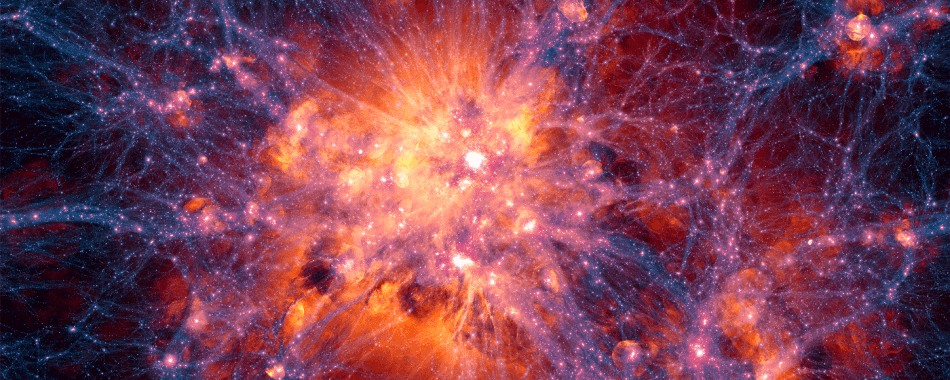Jun 21 2018
Researchers have discovered what could be the last of missing matter in the universe—offering an explanation to the long-time puzzle termed as the “missing baryon problem” by astrophysicists.
 A simulation of the cosmic web, diffuse tendrils of gas that connect galaxies across the universe. (Image credit: Illustris Collaboration)
A simulation of the cosmic web, diffuse tendrils of gas that connect galaxies across the universe. (Image credit: Illustris Collaboration)
As part of a new research, an international research team, including researchers from CU Boulder, spotted the last reservoir of ordinary matter hidden in the universe. This matter, also known as baryons, is the constituent of all physical objects that exist, from stars to the cores of black holes. However, to date, astrophysicists had discovered only around two-thirds of the matter predicted by theorists to be produced by the Big Bang.
In order to find the missing portion, the researchers used the radiation emitted from a faraway, extremely bright black hole known as a quasar. This lost matter occurs as oxygen gas filaments at temperatures of about 1 million degrees Celsius in the space between galaxies, stated Michael Shull from CU Boulder, one of the co-authors of the study.
Shull, from the Department of Astrophysical and Planetary Sciences (APS), stated that the outcomes are significant not only for overcoming the baryon problem but also for giving answers to fundamental questions related to the genesis of the universe.
“This is one of the key pillars of testing the Big Bang theory: figuring out the baryon census of hydrogen and helium and everything else in the periodic table,” he stated.
The innovative study, which has been published in the Nature journal on June 20, 2018, was headed by Fabrizio Nicastro of the Italian Istituto Nazionale di Astrofisica (INAF)—Osservatorio Astronomico di Roma and the Harvard-Smithsonian Center for Astrophysics.
Shull stated that the outcomes are the consummation of a two-decade search. In the 1990s, astrophysicists made predictions of the way in which many hydrogen and helium atoms had been formulated in the Big Bang. These baryons are very different from the dark matter constituting the bulk of the mass of the universe—and researchers are yet to find them.
Scientists consider that they have knowledge of where the majority of that ordinary matter landed: nearly 10% in galaxies and up to 60% in diffuse clouds of gas that fill the enormous spaces between galaxies. However, about 30% of the matter is still left unaccounted.
Shull and his team worked to solve this. In 2012, Shull and Charles Danforth, a research associate at CU Boulder, proposed the possibilities for the baryons to be in a web-like pattern in space known as the warm-hot intergalactic medium (WHIM), which is a wild terrain.
“This is where nature has become very perverse,” Shull stated. “This intergalactic medium contains filaments of gas at temperatures from a few thousand degrees to a few million degrees.”
The international team explored for the missing atoms in that perverse territory by pointing a group of satellites at a quasar known as 1ES 1553 - a black hole located at the center of a galaxy absorbs and liberates enormous amounts of gas. “It’s basically a really bright lighthouse out in space,” stated Shull.
Researchers can collect enormous amounts of information by recording the way in which the radiation from a quasar passes through space, similar to a sailor looking at a lighthouse through fog. Initially, the scientists used the Cosmic Origins Spectrograph on the Hubble Space Telescope to estimate a place to find the missing baryons in that fog. Then, they used the European Space Agency’s X-ray Multi-Mirror Mission (XMM-Newton) satellite to home in on those baryons.
The researchers discovered the signatures of a kind of highly ionized oxygen gas dispersed between our solar system and the quasar - and at a density adequately high to, when extrapolated to the whole universe, account for the missing 30% of ordinary matter.
“We found the missing baryons,” stated Shull.
Shull stated that the scientists will have to confirm their discovery by pointing satellites at more bright quasars. He and Danforth, a co-author on the new research, will also investigate how the oxygen gas landed in these enormous pockets of space. They presume that it was liberated through explosions from galaxies and quasars over billions of years. However, how this happened is still a mystery.
“How does it get from the stars and the galaxies all the way out here into intergalactic space?” asked Danforth, who is also in APS. “There’s some sort of ecology going on between the two regions, and the details of that are poorly understood.”